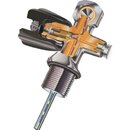.... Only asking...
Me too.
Does the above sound possible, or could the order of events be wrong?
I'm not second guessing the outcome, however I still think it unlikely the tank went airborne before the valve was at least partially sheared. I'm actually not questioning the investigation, but I find it possible there was something misunderstood by the person who typed the report.




